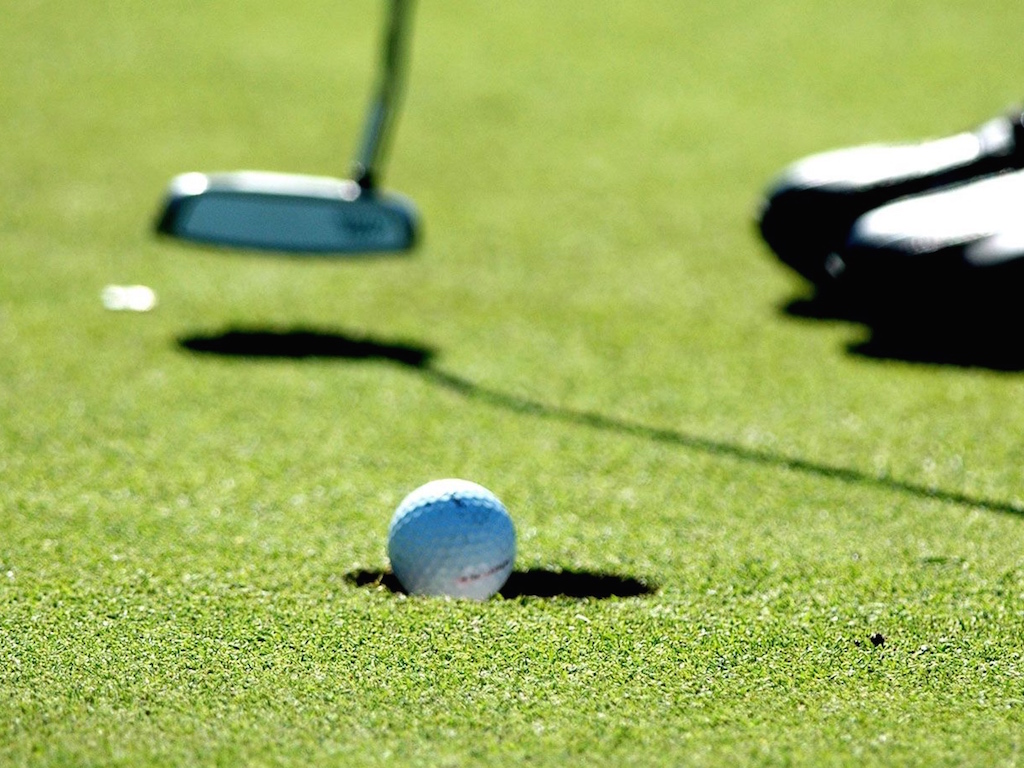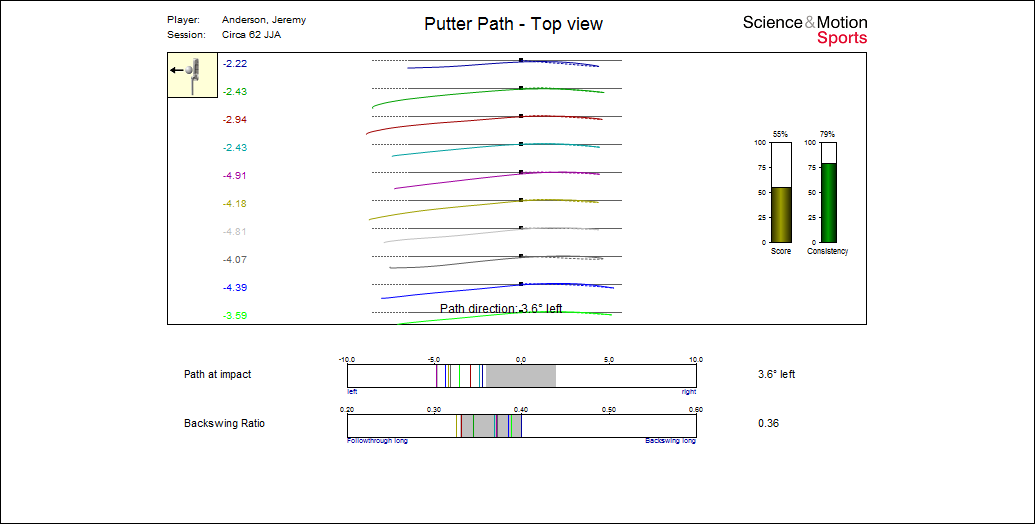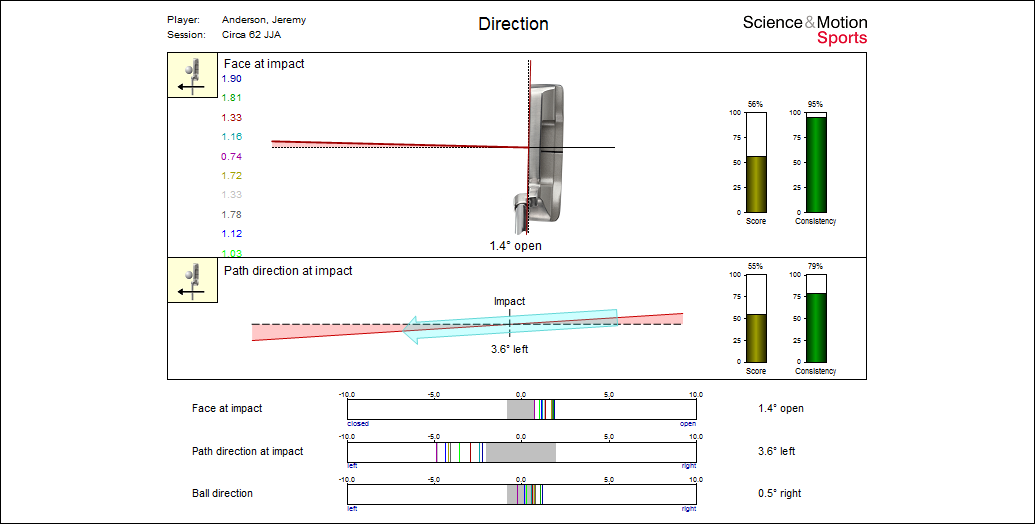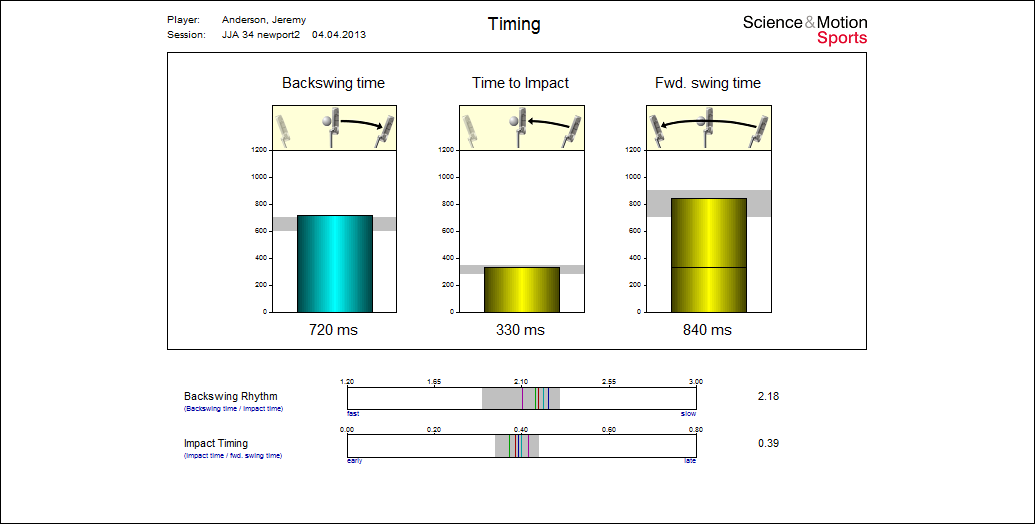Instruction
A recipe for better putting

How do you become a better putter? A reliable recipe would be to consistently roll the ball on your intended line with good speed. It may sound simple, but mastering those two fundamentals takes hard work.
My job as an instructor is to quantify those ideals and a few more, and build on them by digging deeper into a golfer’s putting stroke. I use the S.A.M. PuttLab (Science and Motion), because it helps quantify factors that the naked eye simply cannot see, and yields quicker progressions.
Rolling the Ball On Line
There are two main basic factors that influence a putt’s starting direction:
- Face Angle
- Club Path
We’ll start with the face angle, since studies have shown it has more than twice the importance of path.
Fun Fact: The face at impact is responsible for approximately 83 percent of the ball’s starting direction. So let’s say you are hitting a 10-foot putt and your path is perfectly down the target line, not to the left or right. If your face is perfectly square, you will hit the putt at the center of the hole. If your putter face is one degree off (left or right), however, you will hit the edge of the hole on a 10-foot putt.
That’s right folks. If your face is only 1-degree offline with a zero path your ball could lip in or it could lip out! A true 50/50 ball. As it turns out, putting is pretty hard and there is a pretty small margin for error, but you probably already knew that.
As far as path goes, I have found that most bad putters swing the putter to the left (if they’re right-handed) and cut across the ball with an open putter face. Most golfers also adjust their putter face to compliment their path at impact. However, hitting putts with an open face makes the ball roll worse than its antithisis, the closed putter face.
Notice in the pictures of the report below that the golfer is a left swinger of the putter head, and he gets a lower score because the machine knows that this is not desirable. However, the player is really consistent so the score for consistency is high because the machine knows that the player, although maybe a little volatile, has a repetitive action.
I would change the shape of this putting stroke. If a golfer cuts across putts, then they usually take the putter straight back or even outside the target line and then swing the putter left through impact.
My suggestion is to take the putter inside on the backswing, thus giving golfers a better chance to swing the putter right or down the line through impact. This will help them zero out the path of the putter head. The ball will roll better, allowing golfers to hit more solid and straight putts. When golfers fix the path, the face will — usually within an hour practice session — fix itself.
The speed you need
If you take lessons from different “putting gurus,” you will hear many different brands of verbiage, but consistent philosophies when it comes to speed control. The basic quantifiable fundaments for putting are tempo, timing and consistency of both tempo and timing.
For the sake of this article, I am going to keep this simple.
- Tempo is the rhythm of your putting stroke.
- Timing is how well your mechanics come together with your tempo and in a proper sequence. What is considered “good” is a 2-to-1 ratio between Backswing Time and Time to Impact.
The most important term, however, is consistency. If you are not consistent with tempo or timing you will not have any feel. Your brain needs to have an idea of the pace that you swing the putter. This consistency gives you confidence, and that confidence allows you to commit to your line and roll the ball on that line with the correct pace.
My best tip for better distance control is to always hold your finish while hitting putts.
Understand that putting is very similar to shooting a basketball. Everyone remembers Reggie Miller’s “Goose-Neck” follow through while raining down jumpers in the NBA. It was his attention to detail that made him one of the greatest shooters that ever was. Miss or make, he would be holding his right arm in the same position every single time.
The same goes for putting in golf. You want to hold your finish, your hands and the putter head, in the same position every time (relative to the length of the putt and size of the stroke obviously) and when you do this your timing will become more consistent.
Conclusion
The moral of this story is that there are no shortcuts to making putts. Hard work and dedicated practice is the only way. “If you work hard, your only real opponent is the moment” and it is true.
You think getting better is hard? You’re right. Embrace that notion and enjoy the process!
Instruction
The Wedge Guy: Beating the yips into submission

There may be no more painful affliction in golf than the “yips” – those uncontrollable and maddening little nervous twitches that prevent you from making a decent stroke on short putts. If you’ve never had them, consider yourself very fortunate (or possibly just very young). But I can assure you that when your most treacherous and feared golf shot is not the 195 yard approach over water with a quartering headwind…not the extra tight fairway with water left and sand right…not the soft bunker shot to a downhill pin with water on the other side…No, when your most feared shot is the remaining 2- 4-foot putt after hitting a great approach, recovery or lag putt, it makes the game almost painful.
And I’ve been fighting the yips (again) for a while now. It’s a recurring nightmare that has haunted me most of my adult life. I even had the yips when I was in my 20s, but I’ve beat them into submission off and on most of my adult life. But just recently, that nasty virus came to life once again. My lag putting has been very good, but when I get over one of those “you should make this” length putts, the entire nervous system seems to go haywire. I make great practice strokes, and then the most pitiful short-stroke or jab at the ball you can imagine. Sheesh.
But I’m a traditionalist, and do not look toward the long putter, belly putter, cross-hand, claw or other variation as the solution. My approach is to beat those damn yips into submission some other way. Here’s what I’m doing that is working pretty well, and I offer it to all of you who might have a similar affliction on the greens.
When you are over a short putt, forget the practice strokes…you want your natural eye-hand coordination to be unhindered by mechanics. Address your putt and take a good look at the hole, and back to the putter to ensure good alignment. Lighten your right hand grip on the putter and make sure that only the fingertips are in contact with the grip, to prevent you from getting to tight.
Then, take a long, long look at the hole to fill your entire mind and senses with the target. When you bring your head/eyes back to the ball, try to make a smooth, immediate move right into your backstroke — not even a second pause — and then let your hands and putter track right back together right back to where you were looking — the HOLE! Seeing the putter make contact with the ball, preferably even the forward edge of the ball – the side near the hole.
For me, this is working, but I am asking all of you to chime in with your own “home remedies” for the most aggravating and senseless of all golf maladies. It never hurts to have more to fall back on!
Instruction
Looking for a good golf instructor? Use this checklist

Over the last couple of decades, golf has become much more science-based. We measure swing speed, smash factor, angle of attack, strokes gained, and many other metrics that can really help golfers improve. But I often wonder if the advancement of golf’s “hard” sciences comes at the expense of the “soft” sciences.
Take, for example, golf instruction. Good golf instruction requires understanding swing mechanics and ball flight. But let’s take that as a given for PGA instructors. The other factors that make an instructor effective can be evaluated by social science, rather than launch monitors.
If you are a recreational golfer looking for a golf instructor, here are my top three points to consider.
1. Cultural mindset
What is “cultural mindset? To social scientists, it means whether a culture of genius or a culture of learning exists. In a golf instruction context, that may mean whether the teacher communicates a message that golf ability is something innate (you either have it or you don’t), or whether golf ability is something that can be learned. You want the latter!
It may sound obvious to suggest that you find a golf instructor who thinks you can improve, but my research suggests that it isn’t a given. In a large sample study of golf instructors, I found that when it came to recreational golfers, there was a wide range of belief systems. Some instructors strongly believed recreational golfers could improve through lessons. while others strongly believed they could not. And those beliefs manifested in the instructor’s feedback given to a student and the culture created for players.
2. Coping and self-modeling can beat role-modeling
Swing analysis technology is often preloaded with swings of PGA and LPGA Tour players. The swings of elite players are intended to be used for comparative purposes with golfers taking lessons. What social science tells us is that for novice and non-expert golfers, comparing swings to tour professionals can have the opposite effect of that intended. If you fit into the novice or non-expert category of golfer, you will learn more and be more motivated to change if you see yourself making a ‘better’ swing (self-modeling) or seeing your swing compared to a similar other (a coping model). Stay away from instructors who want to compare your swing with that of a tour player.
3. Learning theory basics
It is not a sexy selling point, but learning is a process, and that process is incremental – particularly for recreational adult players. Social science helps us understand this element of golf instruction. A good instructor will take learning slowly. He or she will give you just about enough information that challenges you, but is still manageable. The artful instructor will take time to decide what that one or two learning points are before jumping in to make full-scale swing changes. If the instructor moves too fast, you will probably leave the lesson with an arm’s length of swing thoughts and not really know which to focus on.
As an instructor, I develop a priority list of changes I want to make in a player’s technique. We then patiently and gradually work through that list. Beware of instructors who give you more than you can chew.
So if you are in the market for golf instruction, I encourage you to look beyond the X’s and O’s to find the right match!
Instruction
What Lottie Woad’s stunning debut win teaches every golfer

Most pros take months, even years, to win their first tournament. Lottie Woad needed exactly four days.
The 21-year-old from Surrey shot 21-under 267 at Dundonald Links to win the ISPS Handa Women’s Scottish Open by three shots — in her very first event as a professional. She’s only the third player in LPGA history to accomplish this feat, joining Rose Zhang (2023) and Beverly Hanson (1951).
But here’s what caught my attention as a coach: Woad didn’t win through miraculous putting or bombing 300-yard drives. She won through relentless precision and unshakeable composure. After watching her performance unfold, I’m convinced every golfer — from weekend warriors to scratch players — can steal pages from her playbook.
Precision Beats Power (And It’s Not Even Close)
Forget the driving contests. Woad proved that finding greens matters more than finding distance.
What Woad did:
• Hit it straight, hit it solid, give yourself chances
• Aimed for the fat parts of greens instead of chasing pins
• Let her putting do the talking after hitting safe targets
• As she said, “Everyone was chasing me today, and managed to maintain the lead and played really nicely down the stretch and hit a lot of good shots”
Why most golfers mess this up:
• They see a pin tucked behind a bunker and grab one more club to “go right at it”
• Distance becomes more important than accuracy
• They try to be heroic instead of smart
ACTION ITEM: For your next 10 rounds, aim for the center of every green regardless of pin position. Track your greens in regulation and watch your scores drop before your swing changes.
The Putter That Stayed Cool Under Fire
Woad started the final round two shots clear and immediately applied pressure with birdies at the 2nd and 3rd holes. When South Korea’s Hyo Joo Kim mounted a charge and reached 20-under with a birdie at the 14th, Woad didn’t panic.
How she responded to pressure:
• Fired back with consecutive birdies at the 13th and 14th
• Watched Kim stumble with back-to-back bogeys
• Capped it with her fifth birdie of the day at the par-5 18th
• Stayed patient when others pressed, pressed when others cracked
What amateurs do wrong:
• Get conservative when they should be aggressive
• Try to force magic when steady play would win
• Panic when someone else makes a move
ACTION ITEM: Practice your 3-6 foot putts for 15 minutes after every range session. Woad’s putting wasn’t spectacular—it was reliable. Make the putts you should make.
Course Management 101: Play Your Game, Not the Course’s Game
Woad admitted she couldn’t see many scoreboards during the final round, but it didn’t matter. She stuck to her game plan regardless of what others were doing.
Her mental approach:
• Focused on her process, not the competition
• Drew on past pressure situations (Augusta National Women’s Amateur win)
• As she said, “That was the biggest tournament I played in at the time and was kind of my big win. So definitely felt the pressure of it more there, and I felt like all those experiences helped me with this”
Her physical execution:
• 270-yard drives (nothing flashy)
• Methodical iron play
• Steady putting
• Everything effective, nothing spectacular
ACTION ITEM: Create a yardage book for your home course. Know your distances to every pin, every hazard, every landing area. Stick to your plan no matter what your playing partners are doing.
Mental Toughness Isn’t Born, It’s Built
The most impressive part of Woad’s win? She genuinely didn’t expect it: “I definitely wasn’t expecting to win my first event as a pro, but I knew I was playing well, and I was hoping to contend.”
Her winning mindset:
• Didn’t put winning pressure on herself
• Focused on playing well and contending
• Made winning a byproduct of a good process
• Built confidence through recent experiences:
- Won the Women’s Irish Open as an amateur
- Missed a playoff by one shot at the Evian Championship
- Each experience prepared her for the next
What this means for you:
• Stop trying to shoot career rounds every time you tee up
• Focus on executing your pre-shot routine
• Commit to every shot
• Stay present in the moment
ACTION ITEM: Before each round, set process goals instead of score goals. Example: “I will take three practice swings before every shot” or “I will pick a specific target for every shot.” Let your score be the result, not the focus.
The Real Lesson
Woad collected $300,000 for her first professional victory, but the real prize was proving that fundamentals still work at golf’s highest level. She didn’t reinvent the game — she simply executed the basics better than everyone else that week.
The fundamentals that won:
• Hit more fairways
• Find more greens
• Make the putts you should make
• Stay patient under pressure
That’s something every golfer can do, regardless of handicap. Lottie Woad just showed us it’s still the winning formula.
FINAL ACTION ITEM: Pick one of the four action items above and commit to it for the next month. Master one fundamental before moving to the next. That’s how champions are built.
PGA Professional Brendon Elliott is an award-winning coach and golf writer. You can check out his writing work and learn more about him by visiting BEAGOLFER.golf and OneMoreRollGolf.com. Also, check out “The Starter” on RG.org each Monday.
Editor’s note: Brendon shares his nearly 30 years of experience in the game with GolfWRX readers through his ongoing tip series. He looks forward to providing valuable insights and advice to help golfers improve their game. Stay tuned for more Tips!














other paul
Mar 24, 2015 at 3:40 pm
i would love to see an article from you about putting alignment and perceived location of the hole. I found I missed 9/10 putts to the right at 10′. Had a laser attached to my putter and it showed I perceived the hole where it is not.
Jeremy Anderson
Mar 24, 2015 at 4:34 pm
Other Paul-
Every golfer searches for perfection. It is better to have really consistent aim than perfect aim. I’ll get on that topic though! Thanks!!
Chris
Mar 23, 2015 at 5:10 pm
I don’t think the results are the result of poor consistency overall and not just a left path as you imply. Here is a link to puttlab report for a 2.8 left path player and I doubt that anyone would say that Loren Roberts was a poor putter: http://www.samsports.us/PuttLab%20Data/LorenRoberts.pdf. Your example players numbers have significant variance in both path and face angle but you also neglect to show the other numbers such as loft at impact and where the ball impacts the face. You state that people with a right biased/close face roll the ball better; how does the ball know that the face is open or closed ? The poor roll is probably more a result of a poorly fit putter and not an open or closed face. Can you explain why you think a “closed” face puts a better roll on the ball give a consistent rate of rotation, center hit, and proper angle of attack/loft at impact?
Jeremy Anderson
Mar 23, 2015 at 5:23 pm
Chris-
I agree! Someone with a good rise into the ball and proper loft will roll the ball well. This is merely my take on a large handful of my students feel. Typically when I see a player swing it straight back the putter is going left at impact. I am just giving a fix to a misconception of straight back/thru feel. I see a lot of straight back to left path with a face open at address.
Chris
Mar 23, 2015 at 5:46 pm
Thanks for the response. I agree with you on the SBST feel resulting in the appearance of SB but left as the stroke goes through the ball; this may also result in the face being closed at impact because of normal rotation. To compensate you get the player manipulating the stroke and holding it open to eliminate the left miss. Manipulation is the real problem and the manipulation can be fixed several ways including changing the stroke mechanics to reduce the left stroke path or fitting the player to a putter that has a slower rotation to naturally be open the correct amount at impact.
Mike
Mar 23, 2015 at 3:20 pm
I always pull putts. Even though the Ping app says my stroke is very consistent and rates me near scratch. I’d give anything to stop pulling them.
A
Mar 23, 2015 at 3:41 pm
I suffer the same problem. My path is usually straight or in to out, and my putter face is square at address and between 1-2 degrees closed at impact (I was told it was like a draw swing-putt). Over 12-17 foot putts, 1 or 2 out of five putts will go in and 3-4 will miss left. This is on a perfectly flat surface using the putt lab.
Wish I could figure out how to keep them straight without feeling like I’m manipulating my stroke.
Chris
Mar 23, 2015 at 5:11 pm
Try a putter with less offset.
Jeremy Anderson
Mar 23, 2015 at 5:15 pm
A-
The less manipulated feeling would be a grip change. Do you think it would feel too awkward to weaken your lead hand on the grip? I’d like to know more about how consistent the rotation of your putter face is..
Jeremy Anderson
Mar 23, 2015 at 4:53 pm
You sound like you roll it well.. You have a different and nearly the opposite problem from what I’m talking about in the article. I would try a slight grip change. I’d like to hear more…. How do you aim?